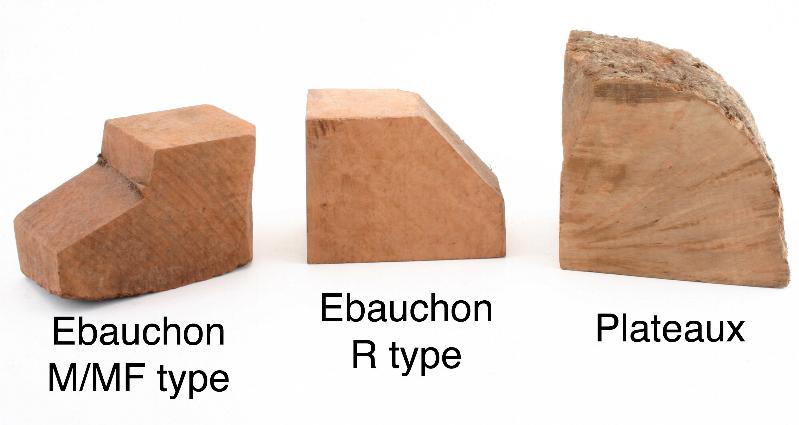A PIPE MAKER'S ODYSSEY: TOOLS OF THE TRADE
By Kurt Huhn |
|
A while back, I started a series of articles concerning pipe making. I completely failed to meet deadline one issue, got sidetracked, one thing lead to another, and things fell by the wayside. A few days ago, I was composing a message to a hobbyist pipe maker, and I suddenly realized what I had forgotten! Then I got a gentle prodding from some NASPC members that were missing my articles, and I decided to spur into action. Tonight, after finally finding some spare moments, I've sat down to continue the series. |
|
In the last articles, I covered the types of tools most pipe makers will use. In this article, I'd like to do a short piece on where to get your briar. In a future article, we can go over the different qualities of briar from different regions, but, for now, let's focus on where to buy it from. Actually, first, let's take a quick look at block shapes, and then we can talk about where to get them. |
The two main shapes of briar blocks, as they come from the cutter, are ebauchon and plateaux. Ebauchon blocks are largely rectangular, are cut from the burl to maximize the number of blocks that can be created, and, as a result, usually have fairly random grain patterns. Most of the pipes that have ever been made from briar have been made from ebauchon blocks. They're typically very economical, costing much less than plateaux blocks, and they're easy to work with, having been squared by the cutter so that they're easy to clamp in a vise or chuck. Plateaux blocks are cut from the outer portion of the burl and still have bark on the outer edge. They resemble a quarter of a circle, by and large, and are usually quite a bit larger than ebauchon. These are typically cut to maximize the grain orientation, and so there are usually fewer garnered from a given burl. Because of this, they're also more expensive than ebauchon. Pipes with striking straight grain are almost always made from plateaux. I've included a snapshot with examples of each shape. |
|
|
Now, where to source the briar? There are three main venues for sourcing briar blocks: pipe-making supply retailers, other pipe makers, and direct from the cutter. Each has its advantages and disadvantages, so keep that in mind when looking to buy your first blocks. I'll go over each in turn. |
Pipe-making supply houses usually deal in large volumes of all manner of pipe-making materials and tooling. For small quantities of anything, these are your best bet for quick and efficient service. You can usually get decent quality briar, but you cannot count on how long that briar has been aged or how it has been stored. Since these places typically look for the best wholesale prices, the cutter they deal with may change from one order to the next, so it is possible that you will not know the origin of the briar you're purchasing. That's not as bad as it sounds, though. As a rule, very high-quality briar is available from pipe-making suppliers. You can even get pre-drilled briar with stems fitted from these places, so that all you have to concentrate on is shaping the pipes and not have to worry about engineering a proper airway with naught but a hand drill. Supply houses include: |
PIMO Pipe Craft |
|
Some pipe makers also are willing to supply briar to hobbyists and other pipe makers. As a rule, these are typically well-established pipe makers with very good relationships with their cutters. They purchase briar by the bushel and sometimes even make trips to the cutter to hand select the briar blocks. Serious hobbyists will also find advantages in fostering a relationship with experienced pipe makers, as most are happy to answer questions on finer points of making pipes. The briar available from other pipe makers is usually of very good quality, since the briar typically comes from the same stock as they use themselves. It can be more expensive buying briar this way, but you get what you pay for. In addition, you can also get pre-drilled kits from these pipe makers, and most will work with you to find a particular block or stem and create the drilling to your specification. That's the advantage of dealing with someone who has all the tooling, as most pipe makers do. Among those pipe makers who also sell briar a re: |
|
Now, for the serious part-time pipe maker and all full-timers, the only place to buy briar is direct from the cutter. The advantages are numerous: low per-block price, excellent and consistent quality, ability to purchase in large volume, and a personal relationship with the supplier. However, for the hobbyist, even the most dedicated, this might not be the most convenient source for briar. Nearly all cutters require a minimum order, with 500 Euro being typical. Because of that, you end up with a great number of briar blocks, perhaps more than the average hobbyist could ever hope to use. Also, since briar only grows around the Mediterranean, you will have to import the briar if you live in the U.S. and deal with international funds transfer. Some well-known cutters are: |
|
And there you have it! No matter who you are, chances are you've found a place to buy as much briar as you need. Next issue, we'll cover how to treat your briar before you start cutting into it. And, yes, I promise that it's already half written by the time you read this. |
